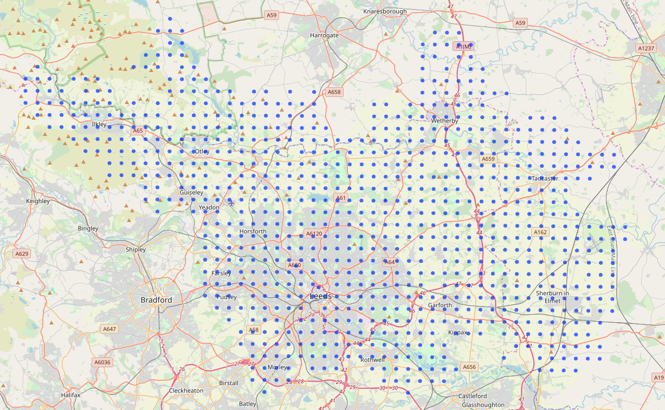Modelling the Joint Effects of Dense Temporal Datasets on Outcomes
This project uses newly constructed functional statistical models to uncover the underlying effects that pollution and lifestyle has on COPD hospital admissions.
Project overview
Using pollution and gym activity data we aim to uncover the links between these variables and COPD hospital admissions. By constructing our own functional statistical models, the objective is to find the timescales over which these variables effect COPD including estimating any effect lags that exist. This result may be useful in predicting COPD hospital admissions in the near future.
Data and methods
Pollution data is collected every 15 minutes from automatic monitoring sites across Leeds, this is available online to the public. Gym activity data is collected from Leeds City Council and is a log of people’s visits to leisure and exercise facilities. COPD data is collected by Public Health England and is a record of admissions to A&E for COPD and asthma. Geostatistical interpolations are used for the pollution data to get a full map of Leeds and a modified historical lag function is used to analyse this data.
Key findings
We have found that the full timescale over which NO2 pollution effects COPD hospital admissions is 28 weeks. More specifically, NO2 effects a person’s health for the first 24.5 weeks and if this exposure is excessive, leads to a hospitalisation for COPD after another 3.5 weeks (meaning there is a lag effect of 3.5 weeks).
Value of the research
This result implies that if we can access accurate historical NO2 pollution data for the past 24.5 weeks, we can predict what the hospital admissions for COPD will look like in 3.5 weeks time. This is vital information that can make a difference in allocating health resources to better cope with predicted spikes in COPD exacerbations and can be used to identify areas in which preventative measures can be taken to better COPD health outcomes
Insights
- We have found that local NO2 pollution around Leeds does effect COPD hospital admissions
- Sustained periods of high NO2 emissions longer than 24 weeks can cause an increase in hospital admissions
- There is an observed lag effect of 3.5 weeks after a person is subjected to an extended period of high NO2 emissions and before they are admitted to hospital

fig 1: PO3- interpolated points for pollution data collection across Leeds

fig 2: PO7- raw(left) and smoothed(right) COPD hospital admissions from different postcode districts across Leeds from 2013 to 2018

fig 3: AN1- General correlation between COPD admission and max NO2 in a district
People
Dr Haiyan Liu – Department of Statistics, University of Leeds
Prof Jeanine Houwing-Duistermaat - Chair in Data Analytics and Statistics, University of Leeds
Dr Georgios Aivaliotis - Department of Statistics, University of Leeds
Vijay Kumar – Leeds Institute for Data Analytics, University of Leeds
Funders
Alan Turing Institute
